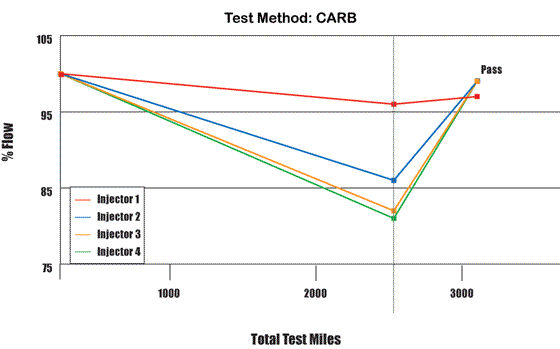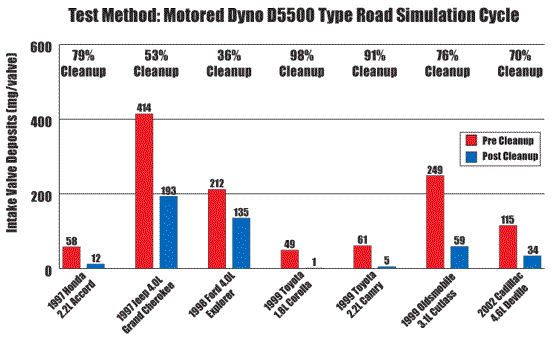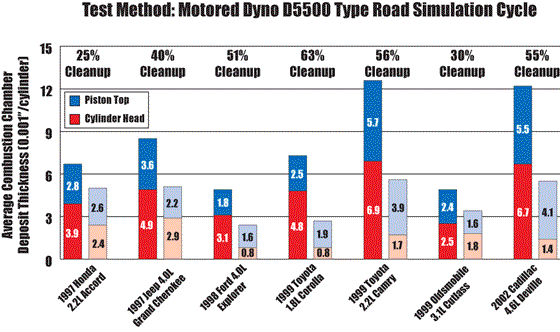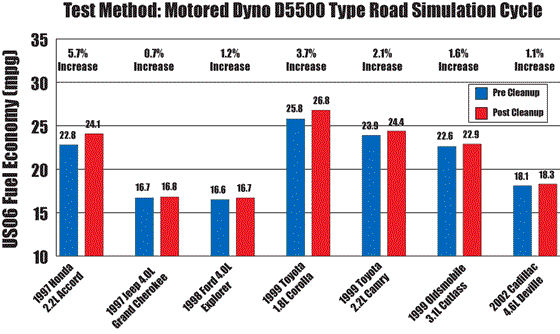

P.i. Performance Improver Gasoline Additive
P.i. improves fuel mileage an average of 2.3% and up to 5.7%. Reduces emissions such as hydrocarbons (HC) up to 15%, carbon monoxide (CO) up to 26% and nitrous oxides (NOx) up to 17%. Restores power and performance. Reduces the need for costly higher octane fuel. (API)
Check out our Performance Study of AMSOIL's Performance Improver and learn how your vehicle can benefit from this amazing product!

Package sizes include: 12-oz. Bottle
Untreated Fuel Leads to Poor Engine Performance
A vehicle demonstrates its best efficiency and engine performance when it is new. As the engine ages, its performance suffers from gasoline fuel-generated deposits that form on the fuel injectors, intake valves and combustion chamber. Additives are required to control deposit formation.
Today’s fuels, however, lack sufficient treatments of either enough additives or high quality additives. Fuel system deposits result in the following:
Lost fuel economy
Lost power and poor throttle response
Failed emission tests
Poor drivability - surging, hesitation, stalling, rough idle
Engine knocking (pinging) and rap
Difficult starts
Treated Fuel Delivers Maximum Performance
AMSOIL P.i. is the most potent gasoline additive available today. As a concentrated detergent, it is unsurpassed in cleaning combustion chamber deposits, intake valve deposits and port fuel injector deposits. AMSOIL P.i. helps maintain peak engine efficiency, fuel economy, power and drivability in newer low mileage engines. In engines with accumulated deposits, testing showed AMSOIL P.i. provided the following clean-up benefits after only one tank of gasoline:
Improves fuel mileage an average of 2.3% and up to 5.7%
Reduced emissions
hydrocarbons (HC) up to 15%
carbon monoxide (CO) up to 26%
nitrous oxides (NOx) up to 17%
Restored power and performance
Reduced need for costly higher octane fuel
Reduced noise from carbon rap and pre-ignition
Better drivability
Smoother operation
AMSOIL P.i. works as an emissions passer. It is ideal for use prior to emissions inspections.
Unsurpassed Deposit Clean-up
Port Fuel Injector Deposits form after the engine has been shut down and there is no gasoline flowing through the injectors. During this hot soak period the injectors heat up and the gasoline remaining in the injectors degrades and forms deposits. This can happen very quickly with the use of poor quality gasoline and short trip driving. Because the clearances within the injectors are extremely tight and injectors must deliver precise amounts of atomized fuel, even small amounts of deposits can cause injectors to malfunction. Fuel flow is reduced and spray patterns are disrupted, decreasing engine efficiency, power and fuel economy, while increasing exhaust emissions.


Intake Valve Deposits form on the intake side or back side of the valves. As deposits increase, they restrict airflow and alter airflow patterns in the cylinder. The deposits disrupt the balanced air/fuel ratio by momentarily absorbing and releasing fuel, and they can cause valve sticking by getting in the way of the valve stem and guide. Deposits also restrict proper seating, and the valves may be burned. Intake valve deposits cause lost engine power, increased emissions, poor engine efficiency and potential valve failure.

Combustion Chamber Deposits form on the top of the pistons and on the cylinder heads. They increase compression and absorb heat during combustion to later release it during the intake cycle. In some engines with tight squish domes, combustion chamber deposits cause the piston to actually hit the cylinder head. This is referred to as combustion chamber deposit interference or carbon rap. Combustion chamber deposits also flake off as they get large, and these flakes can get trapped between the valves and valve seat, resulting in compression loss, difficult starting and rough idle.
Higher compression and stored heat cause increased intake fresh charge temperatures and the increased likelihood of pre-ignition knock or pinging when the fuel spontaneously combusts prior to spark ignition. This increases emissions and may cause engine damage. Many of today’s cars have knock sensors that adjust spark timing to prevent knock.
Although audible knock is controlled, power is lost from retarded timing. Higher octane fuels of 4-5 octane numbers can be used to help prevent knock, an effect called octane requirement increase. As a vehicle ages, more-expensive,
higher-octane fuel is needed to keep it operating at peak performance. By cleaning combustion chamber deposits, knock is controlled, power is restored, fuel economy increases and higher-octane fuels are less necessary for peak performance.

Maximum Fuel Economy
AMSOIL P.i. maximizes fuel efficiency by dissolving and removing fuel system deposits and other contaminants for improved power and overall performance.

Recommendations
Treat one full tank of gas up to 20 gallons with one bottle of P.i. For very large gas tanks, partially fill to 40 gallons and treat with two bottles of P.i. Using more than two bottles per treatment is not recommended. Treat gas every 4,000 miles of service (or 100 hours for marine, stationary and off-road gasoline-powered engines). P.i. helps pass emission tests by running one tank of treated fuel through the engine prior to testing. Safe for use with catalytic converters, oxygen sensors, oxygenated gas and 10 percent ethanol blended gas. Not recommended for two-cycle engines.
DANGER: Combustible. Harmful or fatal if swallowed. Harmful if inhaled. Skin and eye irritant. Read precautions on container before use.
AMSOIL Quickshot SE
Q & A
What is the new AMSOIL P.I.?
The former P.I. was great for its time, but the new AMSOIL P.I. is the latest, most potent chemistry available for cleaning gasoline fuel systems. It does a better job of cleaning fuel injectors and intake valves, plus it cleans combustion chamber deposits. Technology improved in this area, and it is technology that drives AMSOIL.
How often should new AMSOIL P.I. be used?
The new AMSOIL P.I. is so effective it needs to be used only once every 4,000 miles instead of with every tank full, making it far more convenient and cost effective than the former product.
Does P.I. have to be used at exactly 4,000 mile intervals?
No, it does not. P.I. can be used at varying intervals between 3,000 and 5,000 miles and still deliver essentially the same performance benefits. However, using more frequently than 3,000 miles will not deliver extra benefits and using beyond 5,000 mile intervals may sacrifice optimum performance.
How is it possible that you can treat just one tank of gasoline every 4,000 miles?
The new AMSOIL P.I. is the latest, most potent chemistry available for cleaning gasoline fuel systems. Because it works as a super cleaner, there is no need to use it continuously like the former P.I. The former P.I. worked to prevent deposits from accumulating requiring it be used in every tank, while the new P.I. thoroughly removes those deposits accumulated within 4,000 miles.
Why should P.I. not be used with every tank and why does AMSOIL recommend P.I. not be used with more than 40 gallons at a time?
One dose of P.I. is like adding 20 – 30 times the detergent contained in today’s fuels and too much of a good thing is just that, too much. Excessive amounts of detergent can build up in the oil, for example, which can negatively impact performance. There is no need for concern, however, as P.I has been tested for oil compatibility at much higher concentrations than recommended without an issue. Many customers will use one whole bottle (20 gallon treat) in 15 gallons, for example, so over treatments such as this are expected.
Most vehicles do not have gas tanks greater than 40 gallons. Some applications, however, like
marine craft and motor homes, do. Since P.I. is recommended for one tank of gas and marine boats may have 100 gallon gas tanks, one might think that five bottles (one bottle per 20 gallons) should be used. This would be far more than what is needed or recommended. In cases like this, the user should either fill the tank with only 40 gallons of gas and treat that fuel, or deplete a full tank of fuel until only ~ 40 gallons remains, treat that fuel and run until near empty. Additionally, AMSOIL does not recommend treating bulk tanks as the equipment using the bulk fuel will be consuming P.I. with every tank of gas.
Does the new P.I. improve fuel economy?
Yes. In a consumer vehicle test, all vehicles tested showed improved fuel economy. The best result was 5.7% and the average of all vehicles tested was 2.3%.
Testing has shown that AMSOIL PI delivers the following benefits after only one tank of fuel:
• Up to 5.7% increase in fuel economy, and average fuel economy increase of 2.3%
• Up to 15% reduction in hydrocarbon emissions
• Up to 26% reduction in carbon monoxide
• Up to 17% reduction in nitrous oxides
• Reduces contamination of fuel injectors, intake valves, and combustion chambers
How does P.I. improve fuel economy?
It improves fuel economy by doing a superb job of cleaning fuel injectors, intake valves, and
combustion chamber deposits. These deposits interrupt fuel flow and cause computer calculation errors on air-fuel ratio mixtures. By cleaning and keeping fuel system components clean, the engine is able to operate at absolute peak efficiency and fuel economy improves.
Will AMSOIL P.I. improve the fuel economy in new cars?
Engines operate their best when new, but their efficiency slowly degrades over time. Since a new engine will not have deposits, there is nothing to clean up, so P.I. will not have an initial fuel economy improvement. Even so, it does have a positive effect on fuel economy long-term as it helps keep deposits from accumulating to the point where fuel economy suffers. It is highly recommended that AMSOIL P.I. be used at the recommended interval for new vehicles. This will help to keep the vehicle running its best.
Will AMSOIL P.I. reduce exhaust emissions?
Yes, and in all consumer vehicles tested, AMSOIL P.I. reduced hydrocarbons (HC) by as much as 15%, carbon monoxide (CO) by as much as 26% and nitrous oxides (NOx) by as much as 17%. P.I. works as an emissions test passer where vehicles are periodically tested. It is recommended that motorists treat one full tank of gasoline, run that tank, and fill up again before the test.
Does P.I. contain alcohol?
No, it does not
Does New P.I. act as a fuel stabilizer?
No it does not.
Can P.I. be mixed with AMSOIL Octane Boost?
Yes, but only in the fuel tank. Mixing additives in containers prior to dispensing in the gas tank increases the likelihood of contact and presents a safety risk to eyes and skin. It also violates the warning on the label. Furthermore, the additives require special packaging and certain container construction is not able to handle these products.
Can P.I. be used with a carburetor?
Yes, P.I. will clean carbureted components in addition to intake valves and combustion chambers, which are independent of the carburetor. The same high quality detergents that effectively clean the small orifices in fuel injectors will thoroughly clean carburetors. This is an additional benefit to using the new P.I.
Can P.I. be used in place of expensive fuel injector cleaning systems offered by mechanics and automotive shops?
Absolutely! With regular use of P.I., there is no need for expensive cleanings offered by automotive shops. In fact, if electronic systems suggest the need for fuel injector repair or cleaning, try a dose of P.I. with possibly a second dose and reset the computer before having any work done. The problem might just be cleaned away. Again, the use of P.I. can save time and money by avoiding unnecessary trips to the shop.
Is it okay to use P.I. in consecutive tanks of gasoline as is suggested in the previous answer?
Yes, P.I. can be used in consecutive tanks of gasoline, but it is usually not necessary. Only on rare occasions with extremely dirty fuel injectors would this be required. .
If you accidentally over treat any gasoline-powered vehicle with P.I., for instance adding P.I. after 2,000 miles, do you risk fouling the catalytic converter?
AMSOIL P.I. is will not harm catalytic converters at any treat level.
Can AMSOIL P.I. be used in two-cycle engines?
AMSOIL P.I. is not recommended for two-cycle engines. AMSOIL recommends using AMSOIL synthetic 2-cycle oils, which are premium quality products loaded with detergents to keep engines operating at peak performance, so additional detergents are not required.
How is an engine’s performance reduced without the use of AMSOIL P.I.?
Deposits are formed on valves, fuel injectors, and in the combustion chamber because of contaminants in gasoline or incomplete burning of the fuel.
The following problems can occur due to deposits forming:
• As deposits build up in the combustion chamber, the compression increases, possibly producing an effect called auto-ignition, which causes the premature igniting of the fuel/air mixture. A driver would see symptoms such as pinging, knocking, and run-on. Combustion chamber deposits can flake off and become lodged between the exhaust valve and seat. This results in rough engine operation and poor engine starting.
• Deposits accumulated on fuel injector tips can cause an irregular spray pattern, affecting the droplet size of the fuel, altering the dispersion of the fuel in the combustion chamber and making the air/fuel mixture less efficient for burning. Symptoms such as loss of power, poor gas mileage, and decreased drivability are possible with dirty injectors.
• Deposits on the intake valves can absorb fuel while the engine is cold, altering the fuel/air ratio. Intake valve deposits can cause loss of power, decreased drivability and increased emissions.
Why is a Performance Improver needed in the first place?
Gasoline is not a pure substance. It contains impurities that contribute to the deterioration of the combustion process. The accumulation of carbon and varnish deposits clogs fuel injectors and restricts intake valve seating for reduced fuel economy and increased exhaust emissions. A dirty fuel system contributes to slow starts, rough idle, increased hesitation and poor acceleration.
Can P.I. be used with flex-fuel vehicles and E85 (85% ethanol) equipped vehicles?
Currently, AMSOIL P.I. is only recommended for up to 10% ethanol blended fuels and oxygenated fuels.



